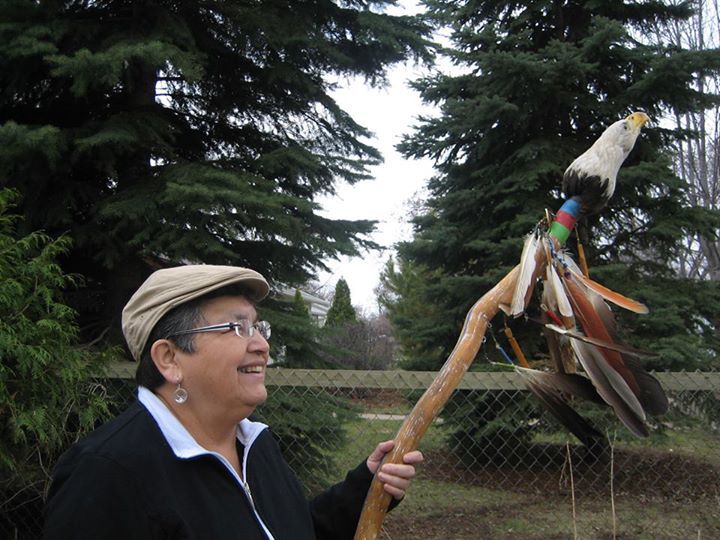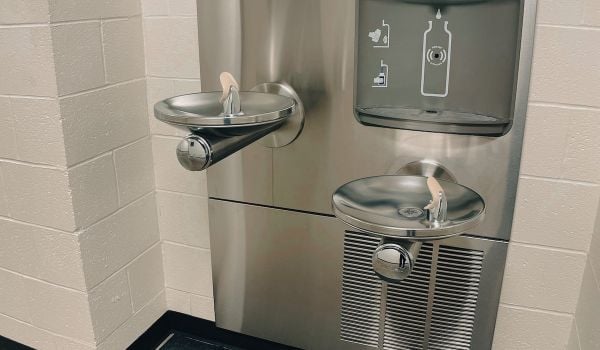It was raining hard on April 28, but that didn’t stop Sharon Day and the two women walking with her on Route 7, along the Ohio River. On they walked, taking turns on foot and riding in a support vehicle, mile after mile, following the river’s meandering path as closely as they could. They were just a few days into a five-week journey that will take them 981 miles from North Shore Riverfront Park in Pittsburgh, where the Ohio begins, to Cairo, Illinois, where it enters the Mississippi.
When I spoke to her by phone that day, she was taking a rest, riding in the support vehicle. She said she did not so much mind the rain. “Even though it makes it uncomfortable to walk, it’s also refreshing,” said Day, an Ojibwe elder who has been leading water walks like this one since 2003, with the goal of raising awareness of the plight of the continent’s waterways.
More disturbing than the downpour, Day said, were the passing trucks carrying fracking wastewater. They splashed the walkers, who were on the road’s narrow shoulder. But far more painfully, they were a constant reminder of the grim conditions that motivated the walk to begin with.
The Ohio River Nibi Walk is a response to the dismal state of the Ohio. (Nibi is the Ojibwe word for water.) The source of drinking water for three million people, it is ranked as the most polluted waterway in the country, absorbing more than 32 million pounds of toxic waste each year as it flows through Pennsylvania, Ohio, West Virginia, Kentucky, Indiana and Illinois. Already, Day and her fellow walkers, along with a support team driving a small RV, had seen the source of that pollution: countless industrial facilities and power plants all along the river’s shores. “From Pittsburgh to where we are now, there’s almost not a mile of the river that does not have some sort of a plant on it,” said Day.
In 2013, Day and other indigenous women walked from the headwaters of the Mississippi, in Day’s home state of Minnesota, to the river’s outlet in Louisiana. “In our spiritual path and our faith, women are responsible to take care of the water,” she told me. “We’re the ones who give life and carry our babies in water. There’s some deep connection to water that we all have.”
On the Mississippi trip, the women carried with them clean water from the river’s source in Minnesota, depositing it 2,300 miles later in the hypoxic environment of the Gulf of Mexico. On this walk, as on that one, they will be carrying an eagle feather staff and praying “with every step,” hoping to call attention to the multiple indignities suffered by the Ohio, whose valley was an important home to indigenous American people for thousands of years before European settlers arrived.
Day had already decided to walk the Ohio when the huge chemical spill on the Elk River in West Virginia happened. The Elk is a tributary of the Kanawha, which empties into the Ohio. Some of that contamination made its way 200 miles downstream, causing the city of Cincinnati to shut down intake valves in its water plants to keep the toxins out of the drinking water there.
“That made us even more determined to walk the river,” said Day. “As we walk, we pray and sing to the river. In our belief, the river is alive and has a spirit. We tell it to stay strong, continue to flow. We’ll do all the other work and encourage everyone else to stop poisoning you.”
Along the way, Day and the handful of women with her stay in donated housing or hotels, and encourage others to join them, even if only for a short time. They have chosen a route that keeps the river in sight as much of the time as possible. “We focus on the river,” she said. “If you could imagine being in ceremony every day — when we walk we don’t talk. If your mind wanders to what’s going on at home, bring it back.”
Being on foot opens up new perspectives. “You see so many things,” she said. “You see the little bumblebee lying on the ground. When you look at the earth from space, all of the water we have is all of the water we’re ever going to have. The more water we consume and waste the less water there is. It’s distressing. At the same time you’re walking a road strewn with garbage but a flower is poking up.”
And so she walks on, through communities that are economically dependent on polluting industries, past nuclear power plants, past the waste and open scars along the riverbank. And she prays.
“As opposed to resisting something, we’re moving toward love,” she said. “Because love is what heals.” And then she told me she needed to get off the phone, and out of the RV, and keep walking.
Watermark is made possible with the support of the Surdna Foundation.

Sarah Goodyear has written about cities for a variety of publications, including CityLab, Grist and Streetsblog. She lives in Brooklyn.













